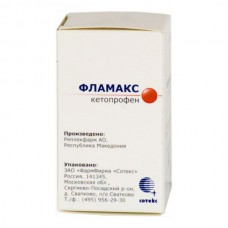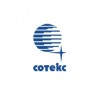Expiration date: 04/2026
The composition and form of issue:
Flamax.
Capsules, 1 capsule contains active substance:
Ketoprofen 50 mg
excipients: lactose monohydrate, microcrystalline croscarmellose sodium sodium lauryl sulfate povidone silica colloidal anhydrous
the composition of the gelatin capsules: titanium dioxide, gelatin, Indigo Carmine FD&C blue
in plastic containers with a screw cap, tamper-evident bags, 25 pieces in a pack a cardboard 1 container.
Flamax-Forte.
Tablets, film-coated. 1 tablet contains active substance:
Ketoprofen 100 mg
excipients: lactose monohydrate, rice starch croscarmellose sodium povidone microcrystalline magnesium stearate sodium lauryl sulphate silica colloidal anhydrous hypromellose macrogol 6000 talc titanium dioxide brilliant blue
blistere in 10 PCs in the paper cartons 2 blister.
Description of dosage form:
Flamax.
Capsules: solid gelatin, ? 2-white body with a lid of blue color. The contents of capsules-a homogeneous white powder.
Flamax Forte
Film-coated tablets: round, biconvex, blue.
Characteristic:
NSAIDs, a derivative of propionic acid.
Pharmacokinetics:
Absorption is rapid, bioavailability is 90%. Up to 99% of absorbed Ketoprofen binds to plasma proteins, mainly albumin. Cmax in plasma is achieved quickly (0, 5-2 hours after ingestion) due to low Vd (0, 1-0, 2 l/kg). CSS Ketoprofen in plasma is achieved 24 hours after the beginning of its regular reception. Ketoprofen well penetrates into synovial fluid and connective tissue. Cmax in synovial fluid is 30% of the concentration in serum, and 4-6 hours after administration exceeds it. Ketoprofen penetrates through the BBB. Almost completely metabolized in the liver by glukuronirovania, has a first pass effect through the liver. It is excreted by the kidneys (mainly) and intestines (1-8%). T1/2 — 1, 6-1, 9 hours in elderly T1/2 increases to 3-5 hours, in patients with renal insufficiency (Cl creatinine 20-60 ml / min) is about 3, 5 hours does not cumulate.
Description of the pharmacological action:
It has anti-inflammatory, analgesic and antipyretic, antiplatelet effect. Inhibits the activity of COX-1 and COX-2 that regulate the synthesis of PG. Analgesic effect is due to both Central and peripheral mechanisms. It has antibacterial activity, stabilizes lysosomal membranes.
Indications:
inflammatory and degenerative diseases of the musculoskeletal system:
- rheumatoid arthritis
- psoriatic arthritis
- Bekhterev's disease (ankylosing spondyloarthritis)
- gouty arthritis (acute gout preferred fast-acting dosage forms)
- osteoarthrosis
pain syndrome:
- myalgia
- ossalgia
- neuralgia
- tendonitis
- arthralgia
- bursitis
- radiculitis
- adnexitis
- otitis
- headache and toothache
- in cancer
- post-traumatic and postoperative, accompanied by inflammation
- algodismenorrhea.
Contraindications:
- hypersensitivity to Ketoprofen or any component of the drug
- bronchial asthma in history caused by Ketoprofen, other NSAIDs, including acetysalicylic acid
- recurrent ulcer disease of stomach and duodenum
- peptic ulcer
- severe hepatic insufficiency
- expressed renal failure
- failure of the circulatory system
- gastrointestinal, cerebrovascular and other bleeding (or suspected bleeding))
- pregnancy and breast-feeding
- children's age (up to 15 years)
- hemophilia and other blood clotting disorders
- ulcerative colitis, Crohn's disease, diverticulitis.
Precautions: anaemia, asthma, alcoholism, tobacco Smoking, alcoholic cirrhosis of the liver, hyperbilirubinemia, liver and kidney (since the drug is primarily excreted by the kidney) insufficiency, diabetes, dehydration, sepsis, congestive heart failure, swelling, arterial hypertension, ischemic heart disease, blood disorders (including leukopenia), stomatitis, children's age (over 15 years), old age.
Side effect:
From the digestive system: NSAIDs-gastropathy, abdominal pain, dyspepsia (nausea, vomiting, heartburn, flatulence, decreased appetite, diarrhea), stomatitis, taste change, ulceration and perforation of the gastrointestinal mucosa, gum, gastrointestinal, hemorrhoidal bleeding increased activity of hepatic transaminases in the blood serum, hepatitis.
From the nervous system: headache, dizziness, insomnia, excitement, nervousness, drowsiness, depression, asthenia, confusion or loss of consciousness, forgetfulness, migraine, peripheral neuropathy.
From the sensory organs: noise or ringing in the ears, blurred vision, conjunctivitis, dryness of mucous membranes of the eyes, eye pain, conjunctival hyperemia, reduced hearing, vertigo.
From the SSS: increase in blood PRESSURE, tachycardia.
From the blood and hematopoietic organs: rarely-agranulocytosis, anemia, hemolytic anemia, thrombocytopenia, leukopenia.
From the urinary system: edema syndrome, cystitis, urethritis, impaired renal function, interstitial nephritis, nephrotic syndrome, hematuria.
From respiratory organs: hemoptysis, dyspnoea, bronchospasm, rhinitis, swelling of the larynx, nasal bleeding, shortness of breath.
From the skin: skin rash, alopecia and eczema, exudative erythema, including Stevens-Johnson syndrome, toxic epidermal necrolysis (Lyell's syndrome), photodermatitis.
Allergic reactions: skin rash (including erythematous, urticaria), itching, rhinitis, angioneurotic edema, exfoliative dermatitis, anaphylactic shock.
Other: increased sweating, myalgia, muscle twitching, thirst, vaginal bleeding.
Drug interaction:
Reduces the effectiveness of uricosuric drugs, increases the effect of anticoagulants, antiplatelets, fibrinolitikov, ethanol, side effects of GCS and mineralokortikosteroidov, estrogen reduces the effectiveness of hypotensive drugs and diuretics.
Joint reception with other NSAIDs, GKS, ethanol, corticotropin may lead to ulceration and development of gastrointestinal bleeding, the increased risk of impaired renal function. Co-administration with oral anticoagulants, heparin with thrombolytic drugs, antiplatelet agents, cefoperazone, cefamandole and cefotetan increases the risk of bleeding.
Increases hypoglycemic effect of insulin and oral hypoglycemic drugs (requires the recalculation of doses).
Inductors of microsomal oxidation in the liver (phenytoin, ethanol, barbiturates, rifampicin, phenylbutazone, tricyclic antidepressants) increase the production of hydroxylated active metabolites.
Joint appointment with sodium valproate causes a violation of platelet aggregation.
Increases concentration in plasma of verapamil and nifedipine, drugs lithium, methotrexate.
Antacids and cholestyramine reduce the absorption.
Myelotoxic drugs increase the manifestations of hematotoxicity of the drug.
Method of application and doses:
Flamax.
Inside, during a meal. Under rheumatic diseases-1 caps. on the morning, 1 — day and 2 — on the evening or on 1 caps. 4 times a day. Possible combined use of dosage forms.
Patients with renal insufficiency dose reduced to 33-50%, elderly patients dose adapted to age.
In the treatment of pain and algodismenorei dose if necessary is 25-50 mg Ketoprofen every 6-8 hours.
The maximum daily dose is 300 mg.
Flamax Forte
Inside, during a meal. Adults-1 table. 2-3 times a day (every 8 hours).
The maximum daily dose is 300 mg.
Overdose:
Symptoms: possible appearance of drowsiness, nausea, vomiting, abdominal pain, bleeding, impaired liver and kidney function.
Treatment: symptomatic-gastric lavage and/or the use of activated charcoal and / or other sorbents. There is no specific antidote.
Special instruction:
With the simultaneous use of Ketoprofen and coumarin anticoagulants, including warfarin, or lithium salts, patients should be under strict medical supervision.
Care should be taken when prescribing the drug to patients with ulcerative diseases of the gastrointestinal tract in a history of renal or hepatic insufficiency. During treatment, it is necessary to control the picture of peripheral blood and the functional state of the liver and kidneys. In case of impaired renal and liver function (increased ALT activity is the most sensitive indicator of NSAIDs-induced liver dysfunction), dose reduction and careful monitoring are necessary.
If it is necessary to determine 17-ketosteroids, the drug should be canceled 48 hours before the study.
As well as other preparations of this group, can mask signs of infectious disease.
With the development of disorders of organs of vision it is necessary to consult an ophthalmologist.
During the period of treatment must be careful when driving and occupation of other potentially hazardous activities, require high concentration and psychomotor speed reactions.



